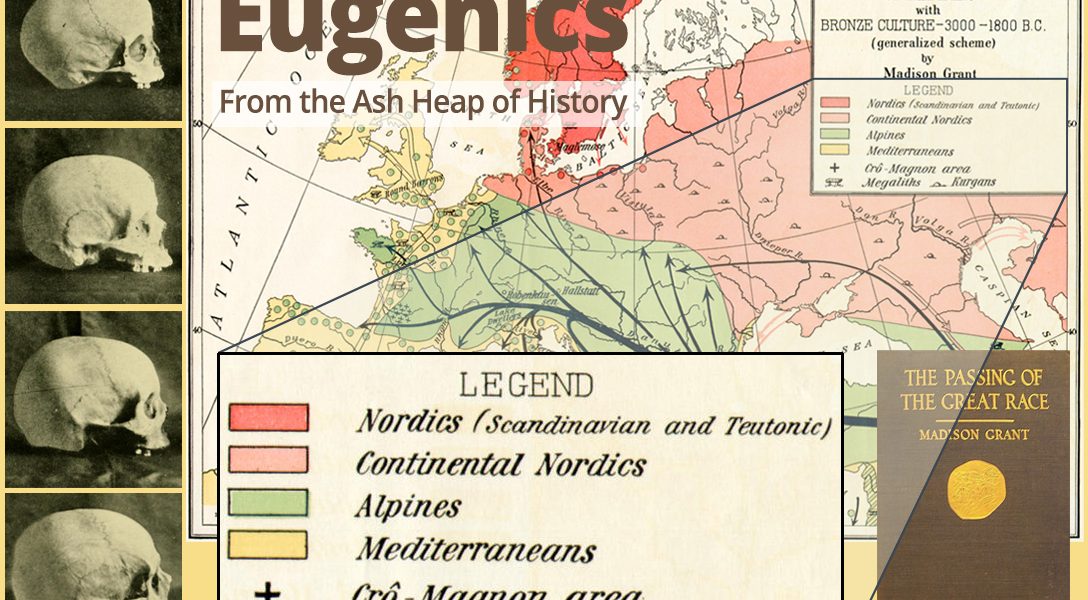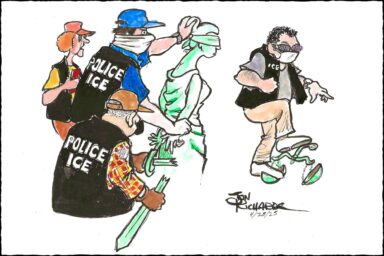A look at how things like the Chinese Exclusion Act, eugenics, and white America’s desire for racial purity have historically been far worse than what we are seeing today — at least so far.
When Ken Cucinelli spoke this week about Emma Lazarus’s words on the Statue of Liberty being meant “only for Europeans,” he was signaling both ignorance of history and a reminder that distrust of the “other” runs deep in the American psyche.
As bad as the pushback against Latin American immigration is today, opposition to immigration of the poor and oppressed from southern Europe in the mid-19th century was even more virulent.
In this week’s WhoWhatWhy podcast we talk with Daniel Okrent, whose recent book The Guarded Gate tells a cautionary tale about how the pseudoscience of eugenics was weaponized to halt undesirable European and Jewish immigration.
He reminds us that the Chinese Exclusion Act was far worse than anything President Donald Trump has yet proposed. Even an avowed progressive like Teddy Roosevelt feared “race suicide:” Because whites were reproducing slower than immigrants, alarmists predicted that “lesser” races would soon take over and “dominate the American bloodstream.”
Okrent explains how eugenics — which began in Britain in the 1860s as a movement to breed the “best of the best” — was used to insert morality into the genetic equation. Even European races were ranked into three categories of descending desirability — Nordics, Alpines, and Mediterraneans — all in the name of modern science.
Just how bad can the immigration battle get? Listen to this week’s podcast to find out.
Click HERE to Download Mp3
Full Text Transcript:
As a service to our readers, we provide transcripts with our podcasts. We try to ensure that these transcripts do not include errors. However, due to time constraints, we are not always able to proofread them as closely as we would like. Should you spot any errors, we’d be grateful if you would notify us.
| Jeff Schechtman: | Welcome to the WhoWhatWhy podcast. I’m your host, Jeff Schechtman.
When Donald Trump’s immigrations czar Ken Cuccinelli spoke this week about Emma Lazarus’s words on the Statue of Liberty only being for Europeans, it simply tapped into a deep strain in the American psyche with respect to immigration and the fear of outsiders. |
| Jeff Schechtman: | It didn’t start with Donald Trump. In fact, it hasn’t even reached its historical apogee under this administration. When Trump talked of murderers and rapists coming to the border, of other nations not sending us their best, he was merely echoing a historical context that has actually played out in far worse ways in our history. From the Chinese Exclusion Act through the highly restrictive immigration acts passed in the early 20th century, the white Christians have always felt under siege. |
| Jeff Schechtman: | To make matters worse, in the early part of the 20th century, the rhetoric and false science of eugenics was weaponized in the immigration battle. Perhaps there is no better time than now to understand this history. To do so, I’m joined by Daniel Okrent. Daniel was the first public editor of The New York Times. He had been editor at large at Time Inc. and managing editor of Life Magazine, and in his recent book The Guarded Gate: Bigotry, Eugenics and the Law That Kept Two Generations of Jews, Italians and Other European Immigrants Out of America, he gives us a frightening reminder of just how bad it can really get. It is my pleasure to welcome Daniel Okrent to the WhoWhatWhy podcast. Daniel, thanks so much for joining us. |
| Daniel Okrent: | Well, thank you for having me. It’s my pleasure to be here. |
| Jeff Schechtman: | When we talk about this period at the end of the 19th century, the early 20th century, talk a little bit about the immigration that was going on at the time, the pushback to that immigration, because it wasn’t eugenics that created the pushback. Eugenics was something that was weaponized in the battle. Talk about that framework first. |
| Daniel Okrent: | That’s exactly right. The big immigration around the time of the Civil War and after was the Chinese immigration, and that led to probably the most specifically racist piece of legislation in American history, the Chinese Restriction Act of 1882 that kept out all Chinese. From that date forward, the immigration from Europe began to pick up, particularly from Eastern and Southern Europe, from Italy first and then from the lands that were under Russian rule and the Russian empire, what is now Poland, Latvia, Lithuania, Ukraine, Russia itself. |
| Daniel Okrent: | These were poor people who were emigrating from their countries, partly out of desperation. The standard of living in Southern Italy particularly was almost medieval, and from religious persecution among the Jews of the Russian empire who were under the thumb of Czar Alexander the second who imposed all sorts of restrictions there, where they could live, what kind of jobs they could have and so on. It really begins to accelerate around 1890, and 1892 Ellis Island opens up and the slums of the large cities of the East coast are filling up. The anti-immigrationists, largely Protestant, largely at first from the upper classes, begin to get really agitated and start to try to get laws changed to keep these people out. |
| Jeff Schechtman: | What was the fear of these people? Where did that come from? Was it the poverty? Was it the economics? Was it the sense that they were different? Where did that fear start to emanate from? |
| Daniel Okrent: | I think the latter of those more than anything else. Of course, the others were also factors, but it seems to be a part of human nature that whatever group you’re in, you have to find another group you can look down on. In fact, in American history, this has been kind of an alternating kind of pattern. As far back as 1750, 1753 exactly, Benjamin Franklin wrote about the Germans who were coming to Pennsylvania and how they were destroying the culture that had already begun to form in Pennsylvania. |
| Daniel Okrent: | Then, we go in the cycles where it’s, first we have the land of the free, bring us your huddled masses yearning to breathe free, and then keep out. Then come in, then keep out, then come in, then keep out. At the end of the 19th century, it became a very strong keep out. Apart from the discriminatory aspects of it, there were the economic aspects. The panic of 1893, 1897, they had a serious effect on the employment numbers in the US, and so even the labor unions, the nascent labor unions, they were also very strongly against immigration at that time. |
| Jeff Schechtman: | Was there also a sense of somehow the fragility of the culture, that bringing in outsiders would somehow change things? |
| Daniel Okrent: | Well, this is the beginning of the eugenic idea, which we’ll get to in more detailed later I’m sure. But, Teddy Roosevelt, the great progressive leader, he spoke frequently of what he considered to be race suicide. Race suicide, simply put, was the notion that the white Protestants were reproducing at a much slower rate than these immigrants were, and that in time, the immigrants would take over the nation and dominate the American bloodstream, which is actually a phrase that he and the other anti-immigrationists of the period used. |
| Jeff Schechtman: | It wasn’t just fear of the other and fear of criminality as we heard from Donald Trump a couple of years ago. There was almost the sense that it would change the morality of the country. |
| Daniel Okrent: | This is where the eugenic idea begins to really take root. Eugenics begins in the UK around 1860, 1870, first as a kind of a, in a strange way, a positive idea. Let’s try to breed the best of the best and improve our country, but then it becomes negative. Let’s keep those who are lesser, for whatever reason, from reproducing. The very prominent scientists from some of our major scientific institutions and universities, they actually argued that not only were those things that we would all accept as being genetic, as being heritable, you know, height, hair color, so on and so forth, but these people were, A, less intelligent and, B, more likely to be criminal, and C, they were morally deficient and the eugenicists actually argued that morality was itself something that came down, not through environment, but from the genes. |
| Jeff Schechtman: | There was a Darwinian element to all of this that really drove the train in so many respects. |
| Daniel Okrent: | Yeah. It begins out of that great scientific ferment that arises in the middle of the 19th century with the publication of Darwin’s Origin of the Species. Stop and think about it. Until 1859 and then the acceptance of evolution that followed, the universal view, all but universal view of the origin of mankind was Adam and Eve. Now, if Adam and Eve, they’re parents to all of us, then we are all related. We are all cousins and brothers with one another. But, once you establish, as Darwin did, that we do not come from Adam and Eve, then, well, they’re not as good as we are. We are not as good as they are. There’s this sense of we’re not related any longer, so we can make these discriminatory distinctions. |
| Jeff Schechtman: | How much of this pushback and how much of the anti-immigration sentiment really comes out of this dramatic change as a result of Darwin’s idea, and a really different way of looking at the world? |
| Daniel Okrent: | Absolutely, it does. The other thing that happens around the same time, although it’s not discovered until 1900, is the research of Gregor Mendel, the Moravian monk who really sort of discovered that genetics actually existed, that things were specifically inheritable. The two ideas put together led to the flowering of, or whatever it is that weeds do, but let’s say the flowering of eugenics as an idea. |
| Jeff Schechtman: | Talk about the way in which these two things then came together, the way in which eugenics became weaponized, really, in this anti-immigration battle. |
| Daniel Okrent: | Well, if you go back to 1895 when Senator Henry Cabot Lodge introduces the first really tough anti-Eastern-and
-Southern-European immigration bill, he and his cohorts, they pass legislation through Congress four times over the next nearly 20 years, and four times it’s vetoed by presidents. They aren’t getting anywhere with it. Presidents being very mindful of the rising vote and the ethnic communities in the US, they see reasons to veto at each time. Once by Grover Cleveland, once by William Howard Taft, twice even by Woodrow Wilson. |
| Daniel Okrent: | Then, in 1916 they’re saved. The anti-immigrationists are saved by the publication of a book called The Passing of the Great Race by a very wealthy new Yorker named Madison Grant, who incidentally is also the man who’s responsible for saving the redwoods of Northern California. He was known at the time as the greatest conservationist in the country, and he believed it was all of a piece. We need to preserve the landscape and we need to preserve the bloodstream. He wrote this book that was based on no real science at all, but it was very imaginative and it was very lively in this writing, that argued that we can apply the eugenic idea, not just to individuals, “here’s this person who may not be genetically sound,” but to entire racial and ethnic groups. |
| Daniel Okrent: | There’s a paragraph in the book that’s really, really chilling and kind of is emblematic of his thinking and those of his associates. He divides the European population into three groups. The best at the top are the Nordics. They’re blonde, they’re tall, they’re blue eyed, they’re smart, they’re brave. In the middle, not so hot, are the Alpines. At the bottom are the Mediterraneans who are short and swarthy and they’re not so morally great. He writes that science has established, even though it had not, that the marriage of any two individuals, if they are of different groups, racial groups, that the offspring of that will revert to the lower of the two groups. He writes that the marriage between a Nordic and an Alpine produces an Alpine. A marriage between an Alpine and a Mediterranean produces a Mediterranean, and the marriage between any of the three European groups and a Jew produces a Jew. The chilling nature of this, it’s not just chilling because of what he thinks of the Jews, but the implication of this ladder of quality in Europe is really horrifying. |
| Jeff Schechtman: | Talk about the ways in which this filters into the politics of the time, including and perhaps penultimately with Coolidge buying into this. |
| Daniel Okrent: | It becomes something that the anti-immigrationists can pick up to show that they are not being discriminatory, they’re following the rules of science. Instead of saying, you know, we don’t like the Jews, we don’t like the Italians, we don’t like the Greeks, we can just say, “Well, we have this problem with eugenics. They may be fine people, but they’re not the kind of people we want here. They’re going to mess up the bloodstream.” By 1921, Calvin Coolidge, about to be inaugurated as vice president, he writes an article, in Good Housekeeping of all places that says that, now that biological laws, that’s his phrase, biological laws have proven that these people are inferior, we must have legislation to keep them out. |
| Jeff Schechtman: | Then, that ultimately results in, in the passage of this restrictive Johnson-Reed Act in 1924. |
| Daniel Okrent: | Yeah, the Immigration Restriction Act of 1924 is this landmark in American immigration history. First, it reduced the number of immigrants that were allowed in, and then it divided them. They gave quotas to each nation that they came from. The quota was ostensibly based on the percentage of people from any given country who were already in the US, so if the 10% of the American population derived from Germany, then 10% of the new immigrants could come from Germany, and so on. |
| Daniel Okrent: | But, they didn’t use the 1920 census to determine what the population of America was, nor the 1910, nor the 1900. They went back 24 years to 1890 before the large immigration from Eastern and Southern Europe had started, and so the quotas, they cut viciously. There were as many as 220,000 Italians who came in a single year just before the quota went to effect, and after the quota, the Italian immigration was limited to fewer than 4,000 a year. Scariest of all, this law was in place for 41 years throughout the depression, throughout World War II and its horrors, throughout the World War II aftermath when displaced people were all over Europe but couldn’t get out, couldn’t get into the US. This was really a horrible, horrible disruption, I believe, of the natural growth of the American population. |
| Jeff Schechtman: | Just as frightening were the number of people that bought into this, people that were part of, if not the extreme eugenics culture, but really part of the mainstream political and artistic culture of the country. |
| Daniel Okrent: | Right. Many of them were Progressives. Even though there’s a little bit of a distinction between the way we use progressive today and the way it was used then. But, take for an example, Edward Ross. He was a very prominent sociologist at the University of Wisconsin. In fact, he was the president for a while, of the American Sociological Association, and later in his life he actually became the national chairman of the American Civil Liberties Union. But he wrote, as he described the people he saw passing through Union Square in New York, this is around 1914, he’s seeing, and this is a direct quote, “hirsute, low browed, big faced persons of obviously low mentality. Acts like people who clearly belong in skins in wattle huts at the close of the Ice Age.” That’s kind of terrifying. |
| Daniel Okrent: | Joseph Lee was the leading progressive philanthropist and hero in Boston, really. He kept the schools open at night so immigrants could get an education. He founded the Massachusetts Civic League. He supported black voting rights in the South. He also opposed immigration to such a degree, immigration from these countries, that he single handedly financed the lobbying group that actually engineered the law into passage. He wrote at one point that, “All Europe might soon be drained of Jews to its benefit, no doubt, but not to ours.” He also said that he feared the US, if we didn’t do something, would become a dago nation, and this was a great liberal hero. |
| Jeff Schechtman: | What impact did World War II have, and how did that fit into the complexity of these issues? A World War I, I mean. |
| Daniel Okrent: | Well, the horror of it was that … I’m sorry, go ahead. |
| Jeff Schechtman: | World War I, I mean. I’m sorry. |
| Daniel Okrent: | Oh, okay. Well, World War I was viewed by the immigration restrictionists, the anti-immigration people, in the terms of several of them as the white civil war. It was a war between the Northern European countries, England and France on one side and Germany and Austria primarily on the other side, the best of each of these nations going forward into battle, and they’re dying off and providing an opportunity for the dark little man, to use one of Madison Grant’s terms. So there was another cause of panic. Here’s this war that was savage in its intensity that killed off many of those of the same racial background of the anti-immigration movements leaders in the US, so it gave them another argument. It gave them another platform to go on. The other thing that happened at the end of World War I is that immigration, which had paused from 1914 to 1918 for obvious reasons, suddenly picked up again and the boats arriving at Ellis Island and Angel Island in California and elsewhere, they began to appear much more regularly. |
| Jeff Schechtman: | We’ve talked about some of the mainstream folks that bought into this. Talk about what happened when Hitler basically drew on the American eugenics movement for some of his ideas. |
| Daniel Okrent: | Well, the German eugenicists had been collaborating, cooperating with American eugenicists going back to 1905. They were not doing racial genetics, racial eugenics particularly, but they were studying any number of issues that have to do with the inheritance of genes, and they knew each other well. Now, when Hitler arrives, he takes them into his fold. He’d already been reading some of this literature, and in fact cites the 1924 anti-immigration law in a couple of speeches and in his own famous book Mein Kampf. He sees the eugenicists as his greatest allies as he begins his hateful programs. |
| Daniel Okrent: | In 1933, he says to the eugenic physicians in his speech, “I cannot do without you for a single day, not a single hour. If not for you, if you fail me, then all is lost.” He became entirely dependent on them, and these scholars, these scientists who had developed eugenic theory, they were more than happy to join Hitler’s camp, one of them a psychiatrist named Ernst Rudin, he said that, “Only through Hitler’s work has our 30-year-long dream of translating race hygiene into action finally become a reality.” |
| Jeff Schechtman: | How did some of those in America that had bought into this eugenics idea, how did they respond to the way Hitler had embraced this? |
| Daniel Okrent: | Well, some of them went along with Hitler. One man in particular, Harry H. Laughlin, who was the director of the eugenics research office in Cold Spring Harbor, New York and a very prominent figure in the movement and also in the sterilization movement, he actually accepted an honorary degree from the University of Heidelberg in 1936, about three or four months after the university had purged itself of all its Jewish faculty members. But there were also many who saw that when it became, to use the word you used before, weaponized by Hitler, weaponized in such a horrendous way, many scholars and many institutions suddenly said, “Oh my God, look what we have done.” Institutions like the Rockefeller Foundation, the Carnegie Institute of Washington, the American Museum Of Natural History, the Cold Spring Harbor Research Laboratories, they suddenly washed their hands of eugenics. By the end of the 1930s, the eugenic idea as anything that has scientific validity is gone. |
| Jeff Schechtman: | The irony, I suppose, is that it was Hitler’s embrace of eugenics that sped up, at least, its ending. |
| Daniel Okrent: | Absolutely. You don’t want to say thank God for Hitler for anything, but this was at least one positive byproduct. I don’t want to suggest that it died entirely. I mean, even as late as 1939, this is really kind of a horrifying moment in the whole story. There was a bill introduced in Congress by Senator Robert Wagner of New York to exempt 20,000 German Jewish children from the quotas, that they could add on an additional 20,000 people for specifically children, and Laura Houghteling, who was the first cousin of Franklin Roosevelt and married in fact to the commissioner of immigration at the time, she said, “20,000 charming little children will grow up to be 20,000 ugly adults.” Now, that’s not what killed the bill, but the bill did not pass because there was still enough of this sense of a racial distinction, a eugenic distinction prevalent in the land. |
| Jeff Schechtman: | One of the reasons that it seemed to go on for so long is that there were very few voices, or so it seems, that really pushed back and spoke out loudly against the idea of it. |
| Daniel Okrent: | There were some voices, but they just did not carry the day. The leading scientific voice was the great anthropologist Franz Boas who, from beginning in 1917 when he reviews Madison Grant’s book for The New Republic, he devastates the so-called scientific arguments. He shreds them, not just with assertion but with evidence as well. But people aren’t willing to listen and in fact he is dismissed by Grant and others because he was himself, Boas was Jewish so therefore he’s just defending his own people. |
| Jeff Schechtman: | To what extent does it still exist today? What did you find in terms of pockets of it that are still around today? |
| Daniel Okrent: | Well, the pockets don’t exist in the academic and scientific institutions where they once thrived. I mean, the places in addition to the institutions I described before, there’s also Princeton University, Harvard University, and very clearly Stanford University whose president, first president, David Star Jordan was an avid anti-immigrationist, he used eugenicist arguments. The institutions ran from it, and today you can find that lurking in darker corners of the internet. There are, I counted eight different editions of Madison Grant’s, The Passing of Great Race that you can buy online, and these are overwhelmingly racist websites. Extreme right, alt right websites. In the academic world, all those institutions that I described before, all those universities, the eugenicists are either laughed out or chased out of those universities. I don’t see any evidence of there being a credible advocacy for eugenics today. |
| Jeff Schechtman: | Daniel Okrent, his book is The Guarded Gate: Bigotry, Eugenics, and the Law That Kept Two Generations of Jews, Italians and Other European Immigrants Out of America. Daniel, I thank you so much for spending time with us here on the WhoWhatWhy podcast. |
| Daniel Okrent: | It’s been my pleasure. Thank you. |
| Jeff Schechtman: | Thank you, and thank you for listening and for joining us here on radio
WhoWhatWhy. I hope you join us next week for another radio WhoWhatWhy podcast. I’m Jeff Schechtman. If you liked this podcast, please feel free to share and help others find it by rating and reviewing it on iTunes. You can also support this podcast and all the work we do by going to whowhatwhy.org/donate. |
Related front page panorama photo credit: Adapted by WhoWhatWhy from Harry H. Laughlin / Wikimedia and Jouni Lehti / Flickr (CC BY-NC-SA 2.0).






